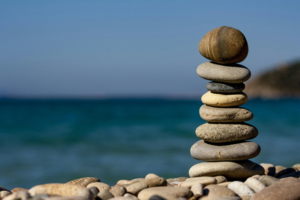As I prepared for the Luxembourg half marathon over the last month I had started to develop some pain outside my right foot. The pain usually occurred on the mid-long runs and then would subside after a few kilometers. I ignored the pain as it didn’t hamper my overall run but recurrence made me curious. Either there was something wrong with my running posture or overuse had caused an injury. Based on my investigation and then consultation with a podiatrist I found out that I have a flat foot which is also leading to some posture imbalance. It amazed me that I had not known about my flat footedness all these years. I did some research on the topic for myself and thought it would be useful to share here as well for awareness. You may be flat footed and wouldn’t know unless you get it checked.
What is flat foot?
As the below diagram shows, flat foot refers to no or low arch when the foot is on the ground. In medical terms the condition is called “pes planus”. The arch in the foot helps effectively spread the impact on the foot and leg helping reduce injuries.
Based on my research I couldn’t find any clear evidence on reasons of developing flat foot. It could be something running in the family or has been picked up as an adult due to prolonged stress to the foot, poor bio-mechanics or just plain old aging. I might be falling in category three 😊

How does flat foot impact running and should you act?
Most people are asymptomatic with no pain or visible issues and in those cases I don’t think there is anything to do except for being aware and doing foot strengthening exercises on a regular basis. I have mentioned a few in the last section of this article.
For people who feel pain in their foot, leg, back or neck after their runs I would suggest getting a quick examination done for a flat foot. It might be the reason for the pain. For example, I have had pain on the left side of the neck due to bad posture during my run which I now understand is driven by a flat foot.
What are the possible solutions?
Insoles (Orthopedic support): Podiatrist can measure the flat footedness or correction required and design custom soles for the feet. These insoles can help relieve the pain or discomfort. I went with this option and for now the solution seems to be working.
Stability shoes: These shoes have supportive features to help compensate for the lack of arch support and reduce the risk of over-pronation during the run. For example, Asics Gel Kayano, Brooks Adrenaline GTS and Saucony Guide are some famous stability shoe series designed for additional support. Will soon do an article on stability shoes. However, before choosing stability shoes I highly recommend speaking to a podiatrist or physical therapist.
Longer term solves
The longer term solve is strengthening of the foot. Everything else in my opinion is a temporary solution. I have mentioned below three exercises which I have found helpful in building foot strength.
- Toe Raises
- Sit in a straight-backed chair with your feet flat on the floor.
- Keep your toes flat on the ground and raise your heels until only the balls of your feet and toes touch the ground. Hold for five seconds.
- Keep your heel off the ground and roll your toes under so that that tops of your toes touch the ground. Hold for five seconds.
- Repeat each position 10 times.
- Tennis Ball Roll
- Sit in a straight-backed chair with your feet flat on the floor.
- Place a tennis ball on the floor near your feet.
- Put your foot on top of the tennis ball and roll it around, massaging the bottom of your foot.
- Roll for two minutes on each foot.
- Achilles Stretch: The cord that runs up your heel into your calf muscles is called the Achilles tendon. Keeping it flexible can prevent foot, ankle, and leg pain.
- Stand facing a wall, with arms outstretched and palms on the wall.
- Place one foot back behind you with knee straight, and bend the knee on your other leg.
- Adjust your stance so that both heels are flat on the floor.
- Lean forward from the hips until you feel a stretch in your Achilles tendon and calf muscle.
- Hold the stretches for 30 seconds each and repeat three times.
- Switch legs and repeat.




